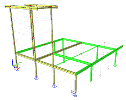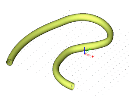Linear versus Non-linear construction stages
Difference between Linear and Non-linear Construction Stages
Linear construction stages
The linear construction stages were developed mainly for the calculation of prestressed structures. It allows the user to model the construction process and life cycle of the structure. Despite the original purpose to apply this module to concrete structures, it can be in general used with any material. The user can add or remove supports, members and tendons. For each construction stage, the safety factors can be set for the permanent and variable load cases including the prestress load cases, thus resulting in a bandwidth of min/max stresses/forces/deformations/reactions. Additionally, the user is able to model the segmentally constructed cross-sections by adding the newly cast (concrete) or installed (steel/timber/other) materials during the construction stage.
The module of Linear construction stages is based on the superposition (linearization) of load cases. Therefore, the user can easily verify results by adding and removing individual load cases.
Note: Module Time dependant analysis (TDA) cannot run without this module.
The drawback of this module is that 2D members can only be added to the structure and not removed. Also, Young’s modules cannot change and hinges can be neither added nor removed.
Non-linear construction stages
The non-linear construction stages were originally developed for the analysis of pipeline systems. In essence, it takes into account the deformed structure of the previous stage, whilst calculating a new construction stage. Therefore, the term "non-linear" is used. This module can work in collaboration with the non-linear conditions and physical and geometrical non-linearity. The input of construction stages for this module follows the same principal and uses the same dialogues as for the linear construction stages.
This module is based on the 2nd order-theory of Newton-Raphson method and requires a proper mesh and incrementing of the load. It generates non-linear combinations, each representing a construction stages. Safety factors are all equal to 1.0, i.e. there is no bandwidth of results (min/max).
The drawback of this module is that it does not work for 2D members and TDA.




